
 Collieries
of the Sirhowy Valley in South Wales.
Collieries
of the Sirhowy Valley in South Wales.
 Collieries
of the Sirhowy Valley in South Wales.
Collieries
of the Sirhowy Valley in South Wales.
The Sirhowy Valley lies north of Risca and south of Tredegar in South Wales, along the River Sirhowy. Early history shows that the area was mainly farmland with a few iron ore workings and furnace sites towards the northern end of the valley. In addition there were many quarries working a variety of minerals from sandstone, millstone through to shales. Prior to the introduction of coke the numerous iron works in the valley were supplied with charcoal from the nearby woods. Another important natural resource in the area was to be found in the hills around Trefil were rich in carboniferous limestone. Limestone and its derivative lime were much needed commodities. Crushed limestone was use as a metallurgical flux in the smelting of iron ore while burnt lime had important uses in agriculture plus the manufacture of mortar.
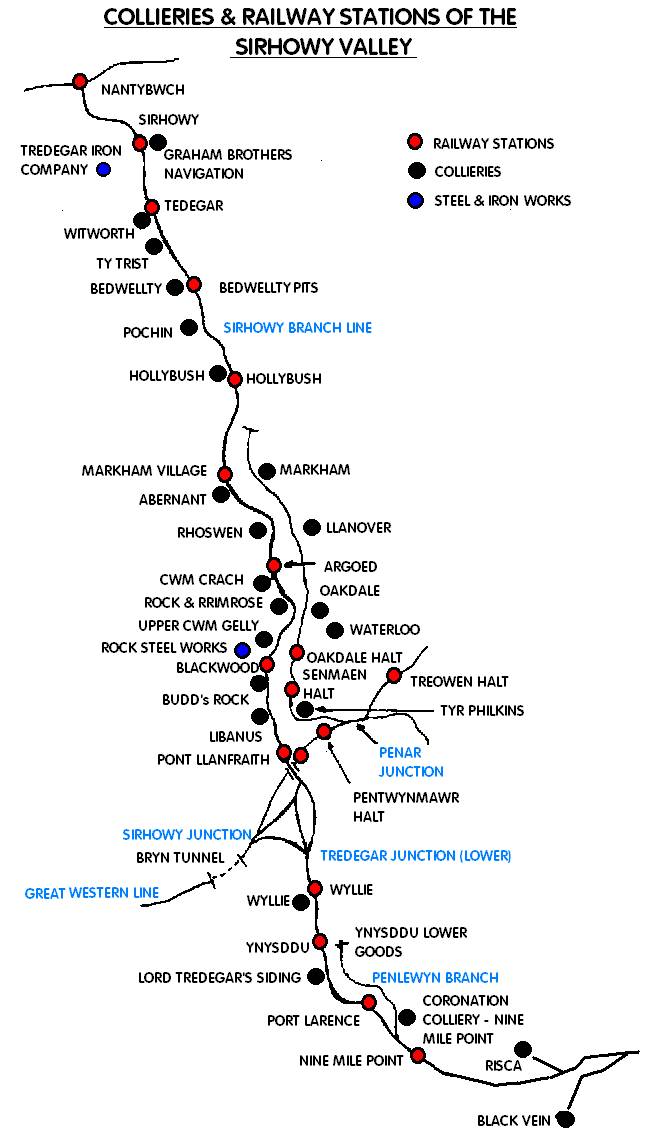
Locations of
the principle Collieries & Railway Stations in the Sirhowy Valley district.Coal was first worked along outcrops in the valley by the miners digging shallow tunnels otherwise known as "adits" or "slopes" which followed the coal seams into the hillsides. The coal was subsequently loaded into baskets made of interwoven twigs and hauled from the tunnels by women or children. The tunnels were driven into the hillsides at a slight incline to allow the drainage of ground water from the mine workings.
During the late eighteenth century there were already a few coal levels working in the Sirhowy Valley. However, it was until the early in the next century that industry in the area was to really take-off with the valley changing forever with clouds of furnace smoke billowing along its length. During this same period the mines of the Rhondda, Cynon and Taff Valleys together with other areas of Monmouthshire were also expanding to meet the needs of the country’s rapid industrial expansion. Coal was not only needed to fuel the new steam engines that powered the industrial revolution but also (in the form of coke) the large number of blast furnaces that were trying to keep pace with the nations new found and insatiable demand for iron and steel.
In 1800 the Tredegar Iron Company (T.I.C.) was formed which after 1873 operated under the title of the Tredegar Coal & Iron Company (T.I.&C.C.). To keep pace with the production from the T.I.C.’s iron furnaces new collieries began to be sunk to supply the endless amounts of coke needed to fuel them. One of the first deep mines in Wales was sunk in 1806 at Tredegar by the T.I.C. This mine was known as "The Dukes Pit", after the Duke of Beaufort on whose land it was sunk. Another pit, Pwll Mawr, at Neath was sunk at about the same time.
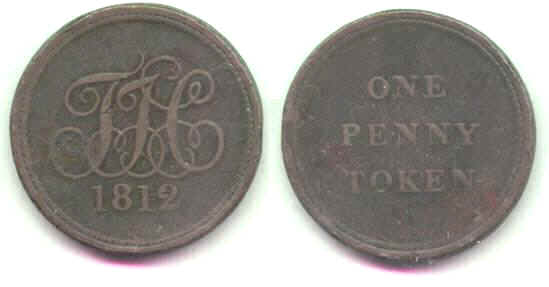
Obverse & Reverse of a one penny "Truck Token" issued by the Tredegar Iron Company (T.I.C.) in 1812 to pay the workers employed in their Ironworks plus coal and ironstone mines in the northern part of the Sirhowy Valley.
All along the Sirhowy Valley the need for coal was becoming greater as iron works and industry became more intense. More coal was being transported down the valley further towards Newport. This increase in demand gave rise to further collieries being opened in the southern end of the valley which in turn required the opening of new railway branch lines to convey the "Black Gold".
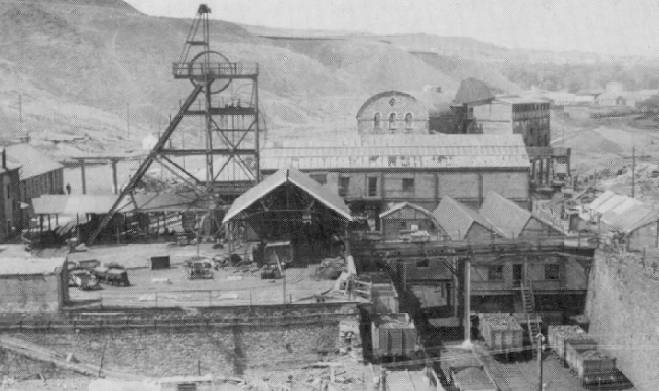
Ty Trist Colliery
in 1954 showing a typically nineteenth century colliery layout.Ty Trist No.1 and No.2 pits were sunk in 1834 by the T.I.C. to supply coke for their ironworks. Upper Ty Trist Pit was sunk in 1841 and followed by the No.3 Pit in 1868. Ty Trist Colliery was one of the 20 pits owned and operated by the T.I.C. It remained in production for 125 years and at its peak employed 1,250 men.

A lamp or cage riding check used at N.C.B. Ty Trist Colliery. Issued during the period 1947 to 1959 when the pit finally closed.
Pochin Colliery a little further to the south was sunk in 1876 and continued in production until 1968. The colliery was named after Laura Pochin, a daughter of one of the directors of the T.I.&C.C. At the peak of its production in 1910 this mine employed 1700 workers and was one of the first collieries to use compressed air.
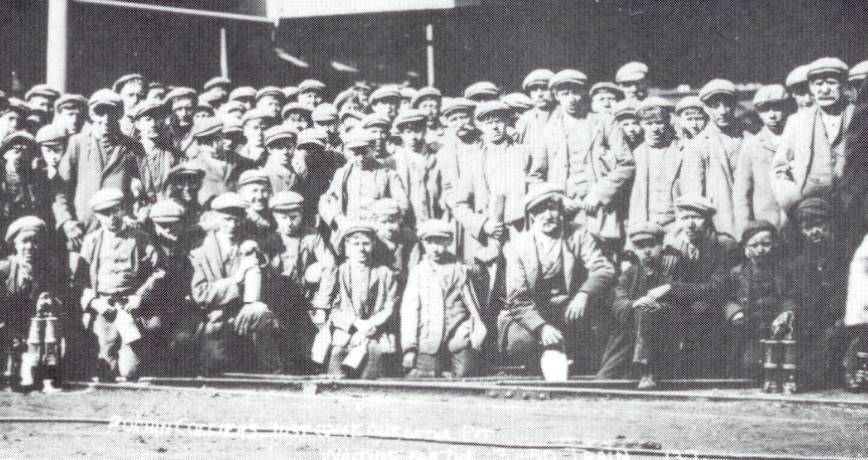
ABOVE - Day Shift workers at Pochin Colliery waiting to catch the 3:50 pm train back to Tredegar in the early 1900s.
BELOW - An un-issued T.I.C. colliers railway pass. These were issued by the company to their workers and presumably allowed them free rail passage between Pochin Colliery Halt and Blackwood Station which were both on the LNWR's Sirhowy Valley Line. Pochin Colliery Halt initially appeared on public timetables but after October 1922 only advertised workmen's trains stopped there.
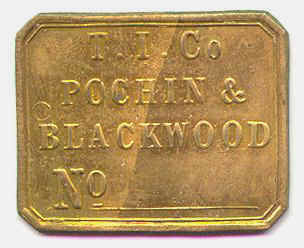
Another Sirhowy Valley colliery was Abernant (not to be confused with the mine of the same name in the Swansea Valley). Abernant was sunk by the Bargoed Coal Company in 1880 and had two shafts, East and West Pits. Abernant later became linked underground to a neighbouring colliery at Llanover. In 1890 over one thousand bags of coal were sent to consignees everywhere to advertise the fact that Abernant Colliery produced the best "smiths" coal in Wales. Abernant Colliery raised its last coal in 1932 and by 1934 was being maintained purely as a pumping station to assist in the drainage of neighbouring pits.
Other pits of note in the Sirhowy Valley included;
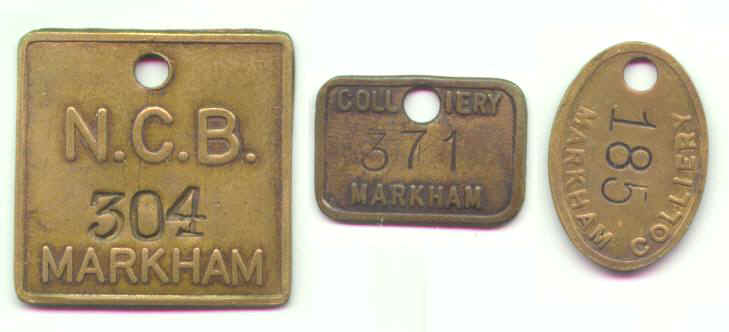
A lamp check
plus two smaller manpower deployment checks used at N.C.B. Markham Colliery. All are believed to have been issued during the period between the late 1960's and 1985 when the pit closed.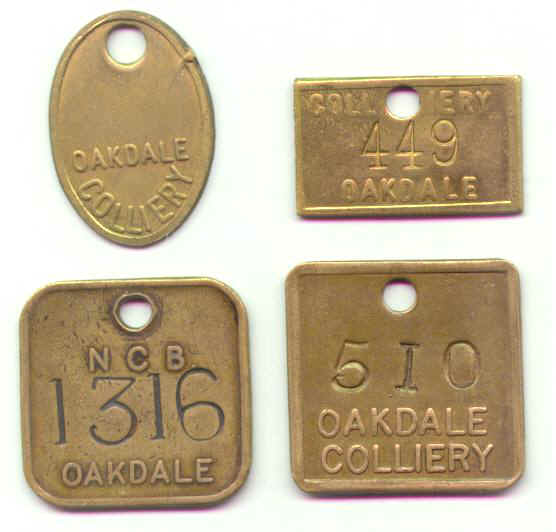
Two square lamp checks plus two smaller manpower deployment checks used at N.C.B. Oakdale Colliery. All are believed to have been issued during the period between the late 1960's and 1989 when the pit closed.
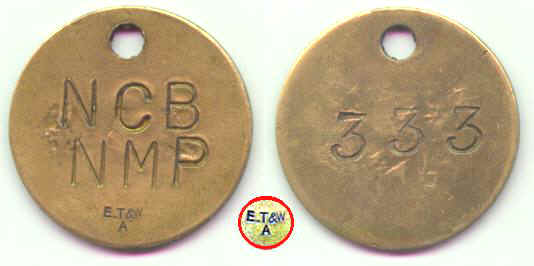
Obverse & Reverse of a crudely hand stamped brass lamp check of N.C.B. Nine Mile Point Colliery dating from the period 1947 to 1964. Note the small die punched initials of the check manufacturer/supplier "E.T&W/A". These initials stand for Evan, Thomas & Williams the well known safety lamp manufacturers of Aberdare, South Wales.

A lamp check used at the Old Black Vein Colliery (O.B.V), Risca. This check must date from the period 1892-1926 when the pit was under the ownership of the United National Collieries.
Throughout the Welsh coalfield, between 1837 and 1927 a total of 3,508 miners lost their lives in colliery disasters. Some of this number who died in the Sirhowy Valley are recorded below by colliery;
|
Date |
Colliery Name |
Number of Men & Boys Killed |
|
1846 |
Risca |
35 |
|
1853 |
Risca Vale |
10 |
|
1860 |
Risca |
146 |
|
1865 |
Bedwellty |
25 |
|
1865 |
Tredegar |
2 |
|
1872 |
Lower Plas, Blackwood |
5 |
|
1880 |
Black Vein |
120 |
|
1882 |
Risca |
4 |
|
1884 |
Pochin |
14 |
The table above indicated some of the recorded disasters, others which may have occurred in small workings were not always recorded. In addition it should be remembered that the statistics do not show the number of miners who died of an earlier injury in the pit, or from lung disease and infection due to poor working conditions, deprivation or poverty.
Based on an article in NMMA Newsletter No.14, Summer 1999. © Ian Ellis.